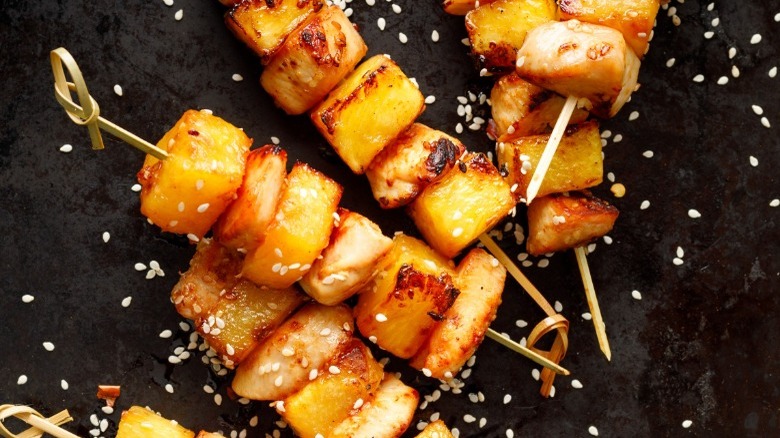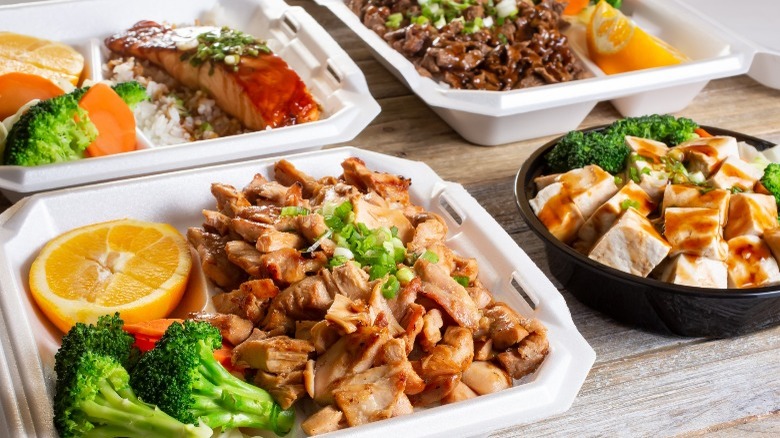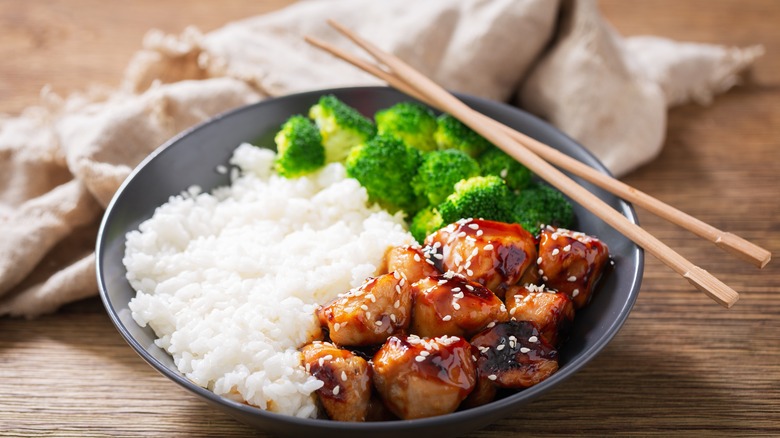Teriyaki Sauce Didn't Originate In Japan. Here's Where It's Really From
Teriyaki is a much-beloved dish. Comprised of juicy chargrilled meat — often chicken but also beef, pork, or salmon — slathered in its eponymous sauce and often served over plain rice, it's an addictive mix of salty and sweet. But teriyaki holds a mystery within its past that moves far beyond the boundaries of its cult-like lunchtime allegiances and incessant late-night-cravings.
Let's just say, teriyaki may not be all you think it is. No, this heady mistress has a secret. She belongs to everyone and no one. Her devotees are both international and legion. The love for this seemingly ubiquitous meal is real, bridging cultures, languages, and even musical genres. Even the mere mention of this succulent, savory treat translated into pop gold for Rosalía's hit song, "Chicken Teriyaki."
But while it's widely assumed that the birth of teriyaki was in Japan, the truth is that its origins are more complex than you might ever have guessed and its roots reside firmly in America.
Isn't Teriyaki Japanese?
So is teriyaki Japanese? The answer is — not really. Though the name itself is Japanese, you probably won't find teriyaki on a list of must-try Japanese meals. Although the dish we've all come to know and love was most likely inspired by a 17th-century Japanese cooking style for fish, of the same name, those dishes themselves share only cursory elements in common with the ingredients in modern meat-focused teriyaki.
Japanese cooking instructor Ayako told The East Bay Times, "'Yaki' means grill in Japanese, and 'teri' means shine — The marinade is a way of making fish shine while it's cooking on the grill." But this way of glazing fish with a shimmering sauce is not traditionally used on poultry, pork, or beef in Japan, so you won't find teriyaki chicken shops packing the streets of Japan the way they do in Seattle.
The truly Japanese version is a very simple sauce and is not syrupy or viscous but thin and light, according to The Spruce Eats. Ayako explained that it's made of soy sauce, sake, mirin, sugar, and ginger, and is meant to be layered, infusing a bit of umami pop to otherwise mildly flavored varieties of fish. It is used as a marinade, basting, and dipping sauce.
Where did modern teriyaki come from?
Where the current incarnation of this much-beloved salty–sticky-finger-licky dish evolved is also full of complexities. What we know is that teriyaki, as we have come to crave it, is widely believed to have been birthed in America by Japanese immigrants trying to recreate dishes from home. However, the timeline of where in America, when, and exactly who is responsible for morphing teriyaki from a simple fish marinade and slow cooking process to its current version as a convenient, quickly grilled and sugary meat dish is a little less clear.
According to the Japanese Cultural & Community Center of Washington, the Japanese don't generally see teriyaki as particularly noteworthy or as restaurant food. The Center says, "In Japan, people think teriyaki is homemade food. Teriyaki sauce is not famous either; instead, each household has their own family recipe for teriyaki sauce."
This bit of information might very well be the key to the teriyaki mystery and what accounts for all the variance in teriyaki sauce recipes both online and off.
Modern teriyaki's American roots traced
Turns out, Kikkoman — the world's largest producer and Japan's most popular brand of soy sauce – may have played a major part in the introduction of teriyaki into American food culture.
Apparently though, as the Japanese Cultural & Community Center of Washington (JCCCW) explains, in the late '50s Kikkoman hoped to spread its brand beyond Japanese and Japanese Americans, but it struggled to do so. That is until Junki Yoshida, a Kyoto-born immigrant to Seattle, began marketing soy sauce by using it in food samples he gave away at his grocery store.
As the story goes, Yoshida began sharing his mother's teriyaki recipe at these samplings and it became a hit, allowing him to go on to teach cooking classes and publish a collection of recipe books all using soy sauce. The JCCCW notes, "His success led to the spread of soy sauce and teriyaki sauce in the American food culture."
But here's where the story gets a bit more controversial. It's widely accepted that immigrants introduced teriyaki to America, but exactly who was the first immigrant to transform it into its modern American form here is still up for some debate.
Hawaii versus Seattle
Though the JCCCW points to Junki Yoshida and Kikkoman as the point of American origin, Kikkoman itself says that although it brought bottled teriyaki to America, Japanese-Americans in Hawaii are responsible for the modern-day American teriyaki sauce. It explains that "Over many generations, the Japanese-Americans in Hawaii added fresh ginger, brown sugar, pineapple juice, and green onions to the original flavor, and it gradually became the teriyaki sauce we've come to enjoy."
However, in addition to Yoshida, Seattle lays claim to teriyaki's current recipe and popularity through two others — Japanese immigrant, Toshi Kasahara, who Seattle Refined says is widely "considered by many to be the godfather of Seattle-style teriyaki," and Korean immigrant, John Chung, who Eater dubbed, "the unsung godfather of Seattle's favorite comfort food."
Rather than choose just one individual, Seattle Weekly attributes teriyaki's origins to a mix of pedigrees, including Japanese, Chinese, Korean, Vietnamese, and European cuisines, as well as a particularly Seattle influence. But if this is to be believed, who is the true "godfather" of American teriyaki? It all depends on who you ask and what criteria you are measuring by.
Battle for Seattle: Toshi versus Chung
If it's who got there first, the answer appears to be Toshi Kasahara of Toshi's Teriyaki restaurants. According to the Seattle Times, when Kasahara opened his restaurant, he served his signature teriyaki marinated chicken thighs and beef on bamboo skewers with rice, salad, and tea as an unfussy, affordable meal for Seattleites. A few months later, his now-famous teriyaki haven was anointed by the Seattle Times restaurant critic, John Hinterberger in a glowing restaurant review (via the Seattle Weekly).
"[He] wrote an article about us and the next day business went up 3-4 times," Kasahara told Seattle Refined. The positive response led to another successful location.
While giving a nod to Kasahara, Eater points to the importance of Korean immigrant John Chung for seeding Seattle's teriyaki community. Eater says Chung, who created Woks Deli and Teriyaki, John's Wok, and Market Galbee, developed a business blueprint ready-made to help his fellow Korean immigrants start their own teriyaki enterprises.
Chung's version of teriyaki, a merging of the original Japanese cooking style with Korean bulgogi cooking traditions, was conceived in 1979, at his first failed restaurant in Los Angeles. After moving to Seattle, Chung's finely honed business model, coupled with a five-minute cooking time, and the avid support of the Korean church, helped to propel Chung's restaurant. Eater argues that Chung's teriyaki, which he taught to other Korean immigrants who then opened their own shops, is the version most widely spread in Seattle and well known today.
Modern teriyaki is the product of American Immigrants
The question "Where does teriyaki sauce come from?" seems pretty simple on the surface, but, in fact, it's a lot more complicated than it first seems. There's not quite one definitive answer, but instead a long history of reinvention.
Whether Japan, Hawaii, or Seattle or Yoshida, Kasahara, or Chung — whatever origin or "godfather" you choose, what is certain is that teriyaki, as we have come to know it, is truly a fusion American meal. Transformed from a simple, traditional cooking method for fish and once relegated to homemade food in Japanese households, teriyaki is now a much-beloved lunchtime favorite, having spread its gospel from Hawaii and Seattle to the rest of the country and the world. But at the heart of this transformation is a series of American immigrants who made the dish their own. Modern teriyaki was birthed by immigrant ingenuity and had multiple, simultaneous entry points into American culture, each one adding its own secret to the sauce.






